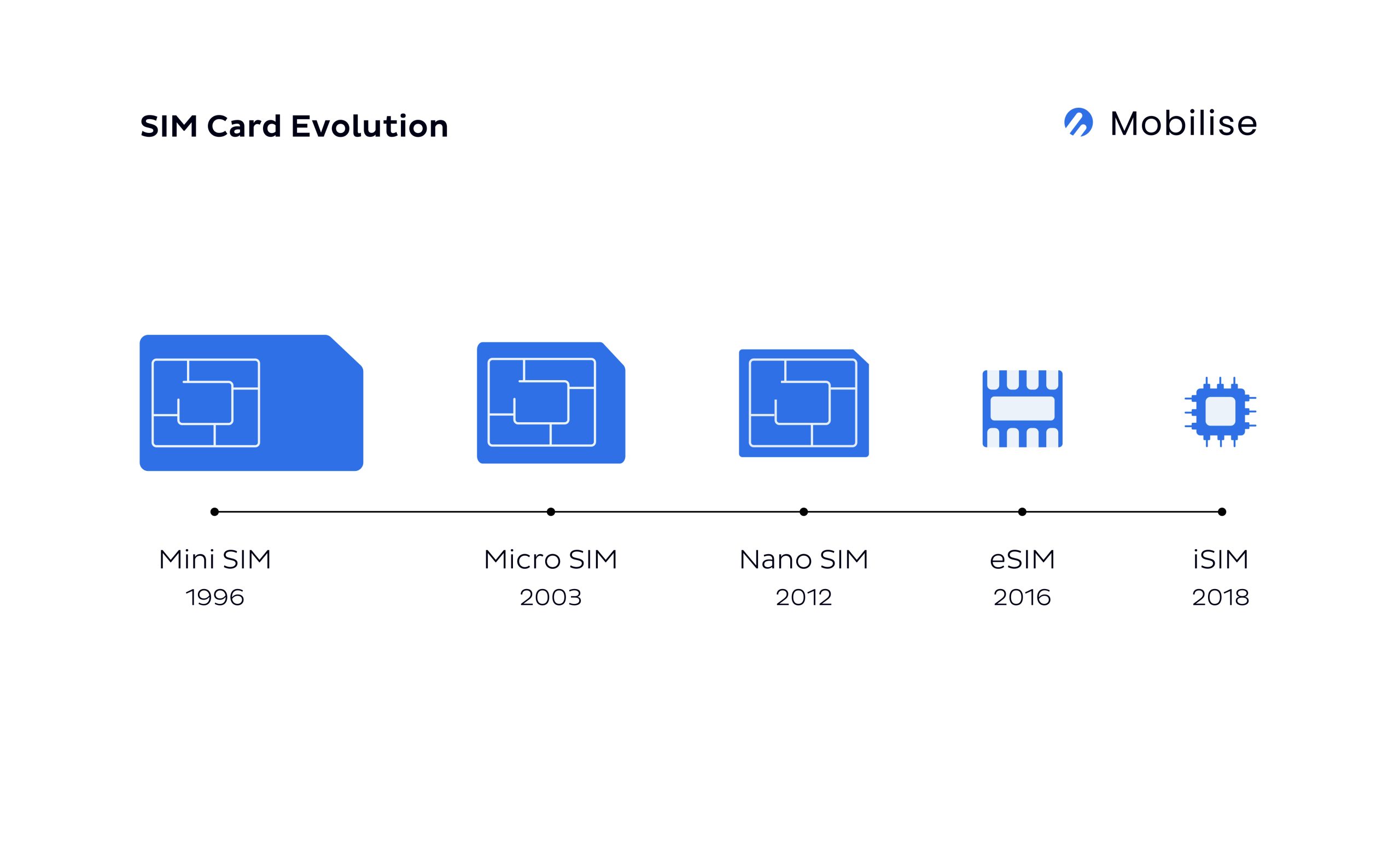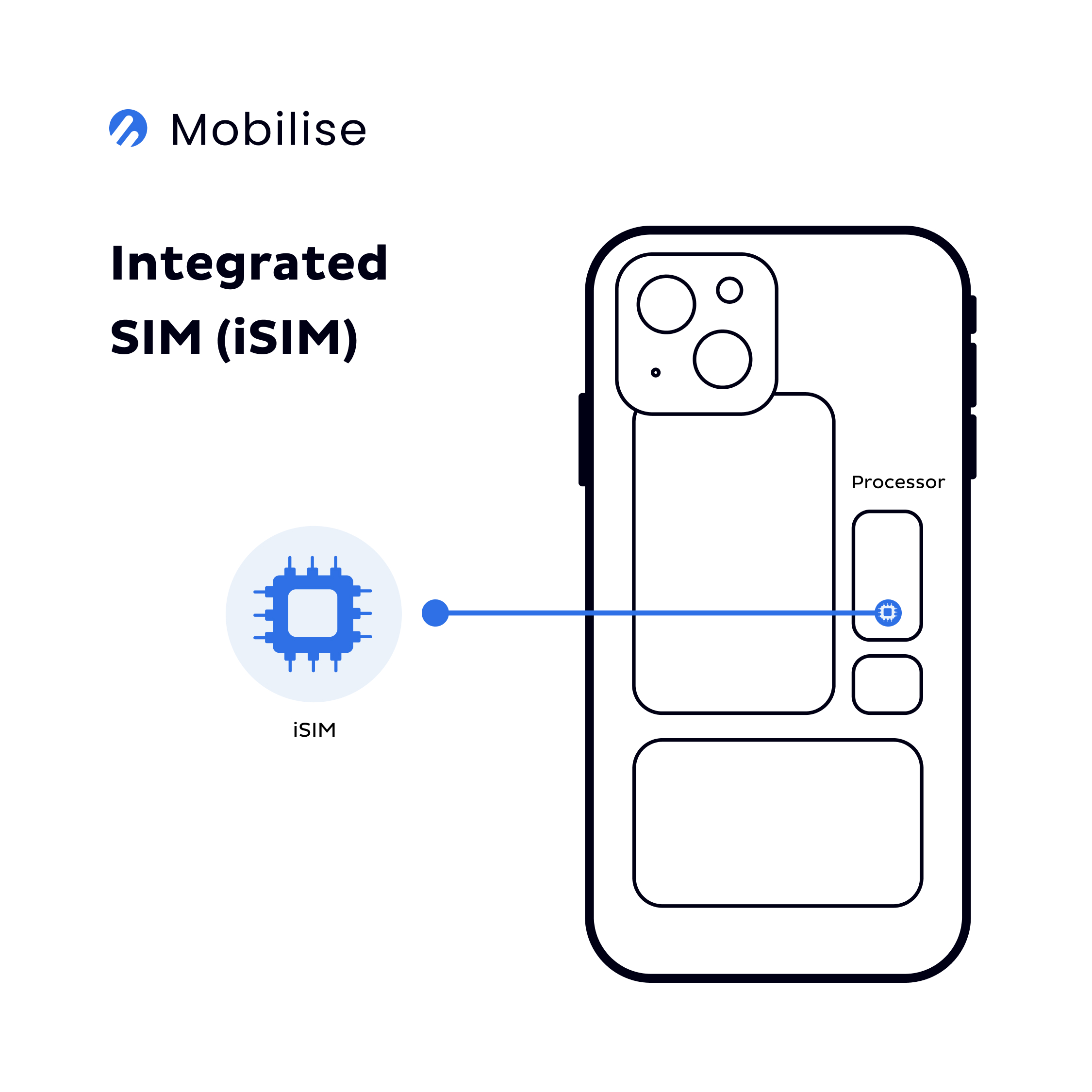Move over eSIMs, iSIM is here! Integrated SIMs (iSIMs) are the next step in subscriber identification modules. And a major move away from physical SIM cards offering connectivity benefits for both consumers and the IoT industry.
What is iSIM?
Integrated SIMs, or iSIMs, are directly integrated within the device’s processor. It’s just like eSIM. But iSIM allows carriers to preload network profiles or remotely provision them on a user’s device. Without them needing to visit a store or acquire a physical SIM in any other way. There are, however, differences that bring benefits to several use cases.
Traditionally, physical SIM cards need a dedicated slot on a smart device. eSIM demands a dedicated chip to initiate its setup. On the other hand, iSIM isn’t soldered onto the device’s circuit board. Instead, an iSIM has a dedicated space on the System on Chip (SoC) where it’s protected by a Tamper Resistant Element (TRE).

eSIM VS iSIM
iSIM is much smaller than eSIM — about 98% smaller, to be precise. Device real estate is a pretty valuable matter. A standalone chip that’s dedicated to eSIM can take up precious space. This smaller size, alongside advancements in low-power silicon modules, opens the door for many IoT use cases.
For instance, iSIM brings heightened visibility to transport and logistics applications. In helping businesses track the location and condition of products shipped worldwide. Smart labels embedded with a low-power connectivity module, an iSIM chip and a battery can power the label for almost a year. It can form the basis of an IoT connectivity solution. One that takes up minimal space yet provides major supply chain insight.
While it may look like any other label, a smart label has the ability to monitor and report any disturbances to the delivery process. Such as if there is a sudden change in temperature that would damage the goods. A notification is immediately sent that triggers an action to resolve the situation.

Ultimately, iSIM changes the way device makers can access cellular capabilities for devices that it couldn’t serve before. If we consider everyday consumer electronics, fitting an iSIM would add zero bulk to the appliance. Like in hair straighteners, for example. What manufacturers could gain though is data on operational conditions and user behaviour. Which can help them improve their products. Additionally, iSIM could also offer a digital interface. This could help consumers control and manage their appliances themselves. Including adjusting parameters such as temperature based on their preferences.
The consumer space
A major benefit of using iSIM for IoT applications is that it can save costs. This iteration of SIM card technology is looking to become the most affordable to date for many IoT devices. For consumer devices, however, this won’t make much of an impact on the overall cost of the device. Certainly, though, it won’t drive prices up. Instead, there are other major benefits for these applications.
First, there’s the size of the chip. A 98% size reduction on eSIM is valuable to OEMs that are constantly looking to add more complexity to a device. With a smaller SIM, there’s more opportunity to add something new. Second, it introduces a chip-to-cloud secure connection, heightening its security credentials. A third major driver for iSIM in both the IoT and consumer space connects to the GSMA standards. Standard SGP.02/22 is separate from the standards and flows used for IoT applications. It defines a technical solution for the remote provisioning and management of eSIM in consumer devices. Which made it challenging for service providers to build a unified solution to address the two sectors.
However, things look set to change with the introduction of standard SGP.31. This will leverage the benefits of existing GSMA eSIM remote provisioning specifications. Which is tailored to the machine-to-machine (M2M) and consumer markets and fills the gaps for IoT use cases. Its aim is to make the use of eSIM more widely available, but that’s encouraging for iSIM too.
We’re already seeing several consumer device OEMs begin to explore iSIM as a result of SGP.31. Already, many Android models are being tested with iSIM for both wearables and handheld devices. And, what’s even better for consumers, is that the transition from eSIM to iSIM can happen seamlessly. Without needing to introduce any changes to the user experience.
Let’s not get ahead with iSIM
It’s undeniable that iSIM is the next generation of SIM technology. Applying cellular connectivity to the unconnected. It’s all part of an exciting future — but we can’t neglect the here and now.
eSIM adoption remains very much underway, and consumer appetite is real. Amdocs reports that 81% of consumers are actively in favour of an eSIM-only future for smartphones. Driven by the prospect of being able to switch between plans seamlessly. But we’re still just scratching the surface of eSIM’s potential. We’ve seen major industry players, such as Apple and AT&T show their support for the technology this year. The launch of the eSIM-only iPhone 14 line acted as a catalyst for change.
For those operating in telecoms, this uptake feels like it’s been five years in the making. While iSIM will undoubtedly offer many exciting benefits for manufacturers and consumers alike. (Including benefits that we’ll all enjoy in the not-so-distant future.) It’s clear the industry is only just beginning to bask in the eSIM era.



